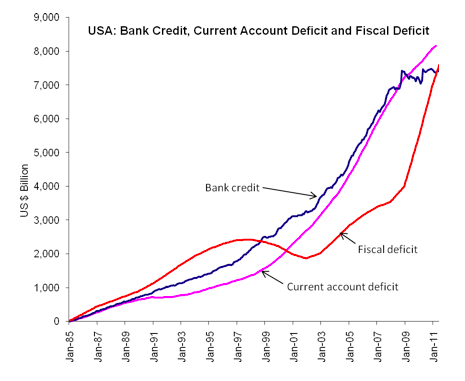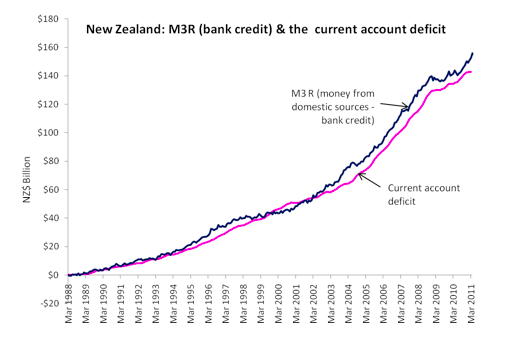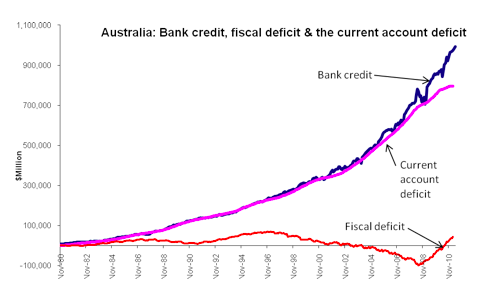Last week I discovered a recent speech by Guy Debelle on the RBA’s position on Australia’s current account deficit (CAD). I thought I would seek a response from Leigh Harkness as he has posted a number interesting articles about CADs over the last few months, and I have also noticed a number of discussion threads on MacroBusiness covering this topic lately.
Please find below Leigh’s response, and don’t forget to check out his website for some more thought provoking material.
In a recent address in Adelaide Guy Debelle, RBA Assistant Governor (Financial Markets) defended the Reserve Bank’s position of not managing Australia’s current account deficits. If the RBA was of the opinion that monetary policy affected the current account deficit and that reducing the current account deficit would improve the stability of the currency, the RBA Act would require the Bank to change monetary policy.
It is normal human behaviour to maintain the status, continue what you are doing and avoid change. However, is this defensive human reaction clouding the RBA’s judgement?
In his speech, Debelle argues that Australian monetary policy does not affect the current account deficit and even suggests that large current account deficits could be a good outcome, and a zero balance a bad outcome.
The following is a synopsis of his main arguments:
1. Summary of the global imbalance argument
Bad current account deficits are those which result from domestic distortions or excessive fiscal positions. Good ones are those which do not have such causes. . . . As long as current account positions are the result of savings and investment decisions by the private sector which are not affected by distortions, then there is no cause for concern. . . . It is important to look beyond current accounts to the whole structure of the capital (financial) accounts [because]:
- . . . current accounts . . . reflect the net outcome of a raft of savings and investment decisions . . . across the whole economy. The current account position is a symptom not the cause.
- the capital (or financial) account, which is the mirror of the current account, is the net of a large array of gross capital flows. These flows reflect the financial decisions taken by both domestic and foreign investors.
. . . it is often noted that Europe has a current account position that is close to zero. . . . there is nothing intrinsically optimal about zero. It may well be the case that the appropriate balance for Europe is not zero but distortions of one form or another have delivered such an outcome. If that were the case (and I am not arguing that it necessarily is), then Europe would be contributing to global ‘imbalances’ as much as those with large current account positions.
The US was able to earn relatively more on its stock of foreign assets than it paid on its foreign liabilities such that its net income position was often in surplus. . . . focusing on the net balance of these flows, which is the current account position, is not particularly helpful relative to more scrutiny of the various components of the gross capital flows.
2. A framework for the defence
a. Within this country there are households that are at various stages of their lifecycle. . . . The young households have current account surpluses, the middle-aged households like me are in current account deficit. But these ‘imbalances’ are not generally cause for concern.
b. Alternatively, we could consider the Australian states. At any point, there can be large current account positions between the Australian states. . . . imbalances across the Australian states are not a cause for concern.
. . . current account positions, even large ones, can exist that are benign and could not be classified as imbalances. The capital flows that are the counterpart to these current account positions are ‘good’, because they are associated with appropriate intergenerational transfers in the first case, and appropriate cross-border flows in an integrated economy in the second.
2.a Reasons to be concerned about capital flows:
- the information asymmetry . . . For example, . . . the US housing market.
- the capacity to borrow in one’s own currency is important.
the economic adjustment that might ensue were they [current account deficits] to narrow precipitously. . . . necessitating a sharp contraction of domestic demand so that the trade balance moves into surplus. Inevitably, this is associated with a domestic recession.
[But in] a world of floating exchange rates . . . the main mechanism of adjustment is the exchange rate. . . . Depreciation is stimulatory to the economy, whereas in the fixed exchange rate world, the adjustment is contractionary.
3. Changes to Australia’s current account and capital flows
Over the past three years, there have been some quite sizeable changes in the size and composition of Australia’s current account and capital account.
From the early 1990s until 2007, Australia recorded a current account deficit which averaged around 4¼ per cent of GDP. There were cycles around that level, with the current account narrowing to 2 per cent of GDP in 2001 . . . and widening to around 6 per cent of GDP in 2007.
At the same time, there was reasonable stability in the major components of the capital account.
One of Guy Debelle’s propositions is that net foreign capital inflow caused current account deficit and that:
The capital flows that are the counterpart to these current account positions are ‘good’, because they are associated with appropriate intergenerational transfers in the first case, and appropriate cross-border flows in an integrated economy in the second.
It is worth noting the following chart before continuing.

I can understand that there may be reasons for capital flows between developed and developing countries, say, from the USA to China. But we are seeing the reverse. Even if international capital flows were related to intergenerational transfers and appropriate cross border flows of an integrated international economy, it would not mean that those capital flows are causing Australia’s current account deficits.
International capital inflow could cause Australia’s current account deficits if it had a fixed exchange rate. The additional money from the foreign capital would enter the economy and raise national expenditure above income, causing current account deficits. Current account deficits generated by foreign capital inflow would be associated with stable or increasing foreign reserves.
But in a country with a floating exchange rate system, international capital flows do not increase the money supply. Hence, they cannot stimulate national expenditure to rise above income and cause current account deficits.
If foreign capital were to drive up the exchange rate so that we shifted some of our expenditure from domestic products to buy additional imports, such transactions would maintain our national expenditure, but would reduce national income. If that capital inflow flow were prolonged, national income would decline and we would experience a recession. That has rarely been our experience in Australia.
In Japan, net private capital outflows have the effect of raising export income above the expenditure on imports. That additional income would suggest that the economy should prosper. It did while bank lending was growing rapidly. However, in more recent years, the growth of bank lending has declined and the additional income from exports is spent on foreign capital rather than on domestic products. Therefore, the additional income from exports is not stimulating the economy. Consequently, the Japanese economy has been relatively stagnant in recent years.
Australia has a similar monetary system, but with current account deficits. If foreign capital inflow were driving our current account deficit, then the only way we could sustain a situation where expenditure exceeded income and simultaneously achieve economic growth would be to create additional money to raise demand.
With the floating exchange rate monetary system, the only significant source of additional money is from the growth of bank credit. As can be seen from the accompanying graph, except for a brief period around the year 2000, any loss of income due to foreign capital inflow driving the current account balance in New Zealand has been fully compensated by an equivalent if not greater increase in the addition expenditure generated by the growth of bank credit.

This credit growth has been very convenient for New Zealand, fully compensating income for the capital inflow in most years.
The close relationship between bank credit and the current account deficit raises the question as to whether it is the independent decisions of New Zealand investors that has been mainly responsible for driving the current account deficit.
In his speech Guy Debelle said:
Bad current account deficits are those which result from domestic distortions.
If a large number of us could print our own money, then the money we printed would enable each of us to buy more than we had produced. When aggregated, those transactions would mean that the whole economy could buy more than it produced, resulting in current account deficits.
Debelle, and those of us who could not print their own money, would consider that those who were printing money were abusing the monetary system. In their opinion, the current account deficits that were being financed by the printed money were the result of a domestic distortion in the monetary system.
We use money to distribute our goods and services. The money we earn from selling goods and services enables us to buy goods and services of equivalent value. From the macro-economic perspective, money constrains the nation’s expenditure to its income: its consumption to its production. If people were to print their own money, they would be stealing products from those who had produced those products. It is for this reason that our laws restrict the right of people to create money.
But would it be a distortion of the monetary system if the government were to create more money to finance its expenditure? If it were not a distortion, we would not need to pay taxes. The government could print all the money it needs to finance its expenditure. Yet that money would have the same effect on the economy as the money we printed in the private sector. It would cause the country to buy more than it produced, resulting in current account deficits.
It is for this reason that governments do impose taxes. If they were to print money to finance expenditure, Debelle, as well as many of us, would consider that a great distortion of the monetary system and call upon the government to implement a more responsible fiscal policy.
What if banks could create additional money to finance investment, surely that would not be a distortion? Guy Debelle’s speech indicates that it is the RBA’s view that investment and savings decisions are independent of each other so that if investment were greater than savings, that would not be a distortion of the monetary system.
In our world of floating exchange rates, when banks lend more than is repaid to them, it has the same effect on the economy as money printed by the private (non-bank) sector, or money created by the government to finance its expenditure: it results in national expenditure exceeding national income and current account deficits.
The reason for this is more evident when we examine bank lending in more detail. Bank lending is a process whereby money: which represents a current entitlement to products; is created from debt: which represents a future obligation to supply products. Essentially, it is the process that converts future obligations into current entitlements. It is no wonder that it causes a shortage of goods in the current time, or a current account deficit.
The consequence of creating additional money from bank credit does not change if the money is lent for worthwhile investment projects. Worthwhile investments may raise national income in the long term. But that is irrelevant to its effect on the current account balance.
The relationship between bank credit and the current account deficit for Australia is shown in the accompanying chart.

It reveals that it is not the government’s fiscal deficit that is responsible for the current account deficit. The only source of additional money that is related to the current account deficits is bank credit.
Bank lending did not always cause current account deficits. In the days of fixed exchange rates, economies held national savings in the form of foreign reserves. Those savings were created when growing export revenues were spent on domestic products, rather than imports. While the domestic dollars were circulating around the domestic economy, the foreign reserves, or national savings, were left idle. If banks were to lend that money for worthwhile investments, they could utilise those savings and enable the economy to accelerate its rate of economic growth. Hence, bank lending could make a legitimate contribution to the economy without causing any imbalances.
Floating the dollar has prevented the economy from accumulating foreign reserves and national savings. As a consequence, banks no longer have a legitimate source of savings to lend. It has meant that any growth in bank lending constitutes a distortion of the monetary system. It has the same effect as any distortion of the monetary system that would allow us to print money to finance expenditure. It:
- raises national expenditure above income;
- raises spending above production;
- raise imports above exports; and
- results in current account deficits.